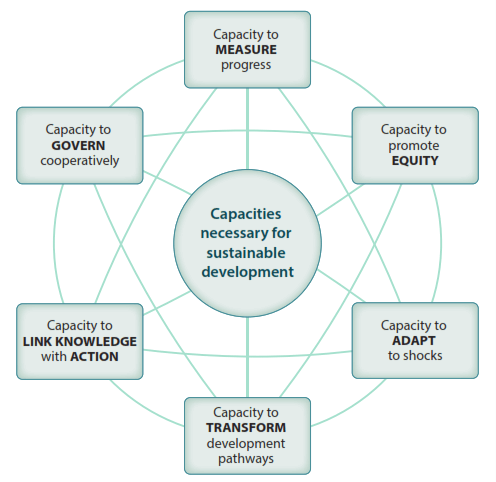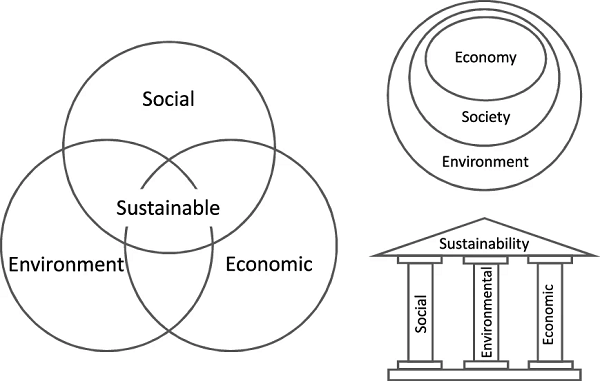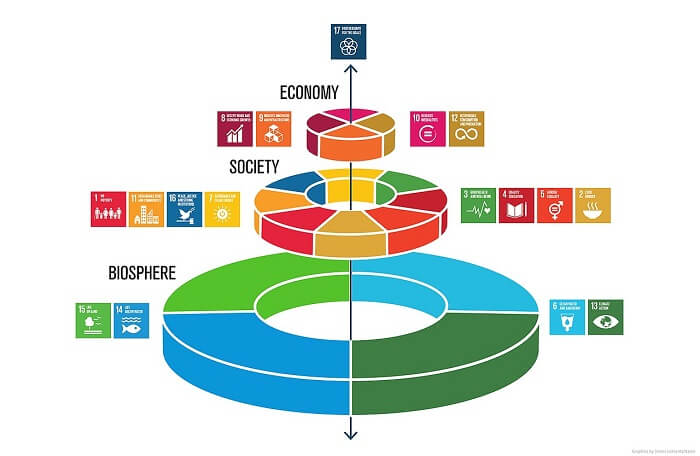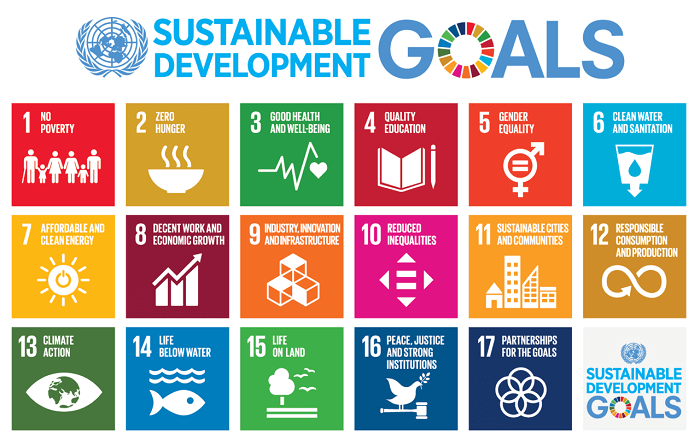Sustainable Development DefinitionSustainable development is a guiding principle that aims to achieve human development objectives while allowing natural systems to support humans with essential natural resources and ecosystem services. The intended outcome is a society where resources are available to meet human needs while maintaining the stability of the natural system and the integrity of the planet. Sustainable development, according to the Brundtland Report from 1987, is "development that satisfies the needs of the present generation without compromising the ability of future generations to satisfy their own needs." The modern definition of sustainable development places an emphasis on the protection of the environment for future generations as well as social and economic development. 
The Rio Process, which was launched at the 1992 Earth Summit in Rio de Janeiro, was the first to institutionalize sustainable development. The Sustainable Development Goals (2015-30) were adopted by the United Nations General Assembly (UNGA) in 2015, and they were described as being integrated and indivisible in order to achieve sustainable development on a global scale. The 17 goals of the UNGA address issues like environmental degradation, poverty, inequality, climate change, and peace and justice. The normative concept of sustainability is linked to sustainable development. "Sustainability is often thought of as a long-term goal (i.e., a more sustainable world), while sustainable development refers to the many processes and pathways to achieve it," UNESCO said in defining the difference between the two concepts. Different angles have been taken to criticise the idea of sustainable development. Others are dissatisfied with the lack of development that has been made thus far, while some find it paradoxical (or an oxymoron) and view it as inherently unsustainable. Because "development" is not consistently defined, this is one of the issues. DefinitionOur Common Future, also known as the Brundtland Report, was published by the United Nations World Commission on Environment and Development in 1987. A definition of "sustainable development" that was included in the report and is now frequently used is as follows. Development that satisfies present needs without jeopardizing future generations' ability to do the same is referred to as sustainable development. Therein are two important ideas:
- Our Common Future, published by the World Commission on Environment and Development (1987) The Concept of Sustainability
The ability of people to live in harmony with one another on Earth for an extended period of time is known as sustainability. It is challenging to come to consensus on specific definitions of sustainability, which have changed over time and with literature, context, and context. Environmental, economic, and social sustainability are often referred to as its three pillars. The environmental aspect is regarded as being the most significant by many publications. As a result, in everyday usage, the term "sustainability" frequently refers to efforts to address pressing environmental issues like climate change, biodiversity loss, ecosystem services loss, land degradation, and air and water pollution. Decisions at the international, national, and personal levels can be influenced by the idea of sustainability (e.g., sustainable living). Dimensions
The environment, economy, and society are considered to be the three dimensions of sustainable development, also known as the pillars, domains, aspects, spheres, globalized, etc. Scholars typically divide sustainability into three categories. These are the social, environmental, and economic factors. For this idea, there are numerous terms in use. Three "pillars," "dimensions," "components," "aspects," "perspectives," "factors," or "goals" may be mentioned by authors. All have the same meaning in this situation. There aren't many theoretical underpinnings for the three-dimension paradigm. There was no single point of origin for it. Rarely do academics contest the distinction itself. In the literature, the concept of sustainability in three dimensions predominates. RequirementsFor the pursuit of sustainable development to be successful, six interdependent capacities are thought to be required. In addition to promoting equity within and between generations, adapting to shocks and surprises, transforming the system onto more sustainable development pathways, connecting knowledge with action for sustainability, and creating collaborative governance structures are some of these abilities. Ecological Features of Sustainable CitiesA sustainable city is one where urban management and planning are used to reduce the urban area's environmental impact. Imagine a city with parks and green areas, solar-powered structures, rooftop gardens, and more people on foot and bicycles than in motor vehicles for the definition of an eco-city. This is not a vision of the future. Better environmental management and greener urban ecosystems are active goals of smart cities. Sustainability in the environment refers to the natural environment's ability to endure, remain diverse, and be productive. The condition of the air, water, and climate is particularly important because natural resources are derived from the environment. In order to maintain environmental sustainability, society must develop activities that satisfy human needs while protecting the planet's life support systems. For instance, this calls for utilizing renewable energy, sustainable material resources, and wise water use (e.g., harvesting wood from forests at a rate that maintains biomass and biodiversity). When natural capital-the sum of all the resources in the natural world-is depleted more quickly than it can be regenerated, an unsustainable situation result. Only using natural resources at a rate that allows for their natural replenishment is necessary for sustainability. The notion of carrying capacity and the notion of sustainable development are intertwined. The inability to sustain human life could, in theory, be a long-term effect of environmental degradation. Herman Daly published crucial operational guidelines for sustainable development in 1990: renewable resources should provide a sustainable yield (the rate of harvest should not exceed the rate of regeneration); for non-renewable resources, there should be the development of equivalent renewable substitutes; and waste generation should not exceed the capacity of the environment for assimilation. Sustainable Development and Gender Issues in LeadershipExamining the relationship between gender and sustainable development, specifically, the potential and challenges of female leadership has been done. Patriarchal structures and perceptions continue to prevent women from rising to positions of leadership in sustainable development, despite the fact that these positions have become more androgynous over time. Women's lack of confidence, which prevents them from obtaining leadership positions, is one of the issues that goes unspoken, but men may be able to support women in leadership positions. BarriersSmall and medium-sized businesses must overcome obstacles when implementing sustainable development, including a lack of resources, a lack of resources, and a high initial capital cost. A global obstacle to sustainable development is a lack of political will. Governments must work together to create a coalition of political and social power in order to overcome this obstacle. Environmental sustainability objectives for the present and the future can be advanced through initiatives to enact reforms or create and implement programs to lessen the negative effects of human behaviors. The Paris Agreement, a multilateral agreement between 193 parties intended to strengthen the global response to climate change by reducing emissions and working together to adjust to its resulting effects, is an example of efforts of political will on a global scale. There is still a strong need for political will, experts continue to say, and governments should take more action outside of the Paris Agreement. Negative externalities that could potentially result from the use of sustainable development technology would be another obstacle to the development of sustainable systems. A prime example would be the creation of lithium-ion batteries, which are essential to environmental sustainability and the decline in the use of fossil fuels. The extraction of lithium from the earth, which uses a process very similar to fracking, and its processing to be used as a battery, which is a chemically intensive process, both have a negative impact on the environment today given the technology and methodology available. One suggested solution would be to consider recycling because it would reduce the amount of old lithium that needs to be disposed of and the need to extract new lithium from the ground. However, this sustainable development solution is prevented from being implemented by a high initial cost because studies have shown that recycling old technology for the purpose of extracting metals like lithium and cobalt is typically more expensive than extracting them from the ground. Sustainable Development Goals
The Sustainable Development Goals (SDGs), also known as the Global Goals, are a group of 17 linked goals that are meant to act as a "common blueprint for peace and prosperity for people and the planet now and into the future." The 17 Sustainable Development Goals (SDGs) are no poverty; zero hunger; good health and wellbeing; quality education; gender equality; clean water and sanitation; affordable and clean energy; decent work and economic growth; industry, innovation, and infrastructure; reduced inequalities; sustainable cities and communities; responsible consumption and production; climate action; life below water; life on land; peace, justice, and strong institutions; and partnerships for the goals. By putting sustainability at the forefront of their goals, the SDGs highlight how interconnected the environmental, social, and economic facets of sustainable development are. The SDGs were developed in 2015 by the United Nations General Assembly (UNGA) as a component of the Post-2015 Development Agenda, which sought to establish a long-term global development framework to succeed the Millennium Development Goals, which were completed that year. The 2030 Agenda, also known as Agenda 2030, is the official name for the set of goals that were formally stated and adopted by the UNGA. A UNGA resolution that identifies specific targets for each goal and offers indicators to gauge progress on the SDGs was adopted on July 6th, 2017, making them more "actionable." The majority of the goals must be accomplished by 2030, though some have no set deadline. There are issues that cut across all the goals and connections between them. For instance, the IPCC notes strong connections between SDG 13 on climate action and SDGs 3 (health), 7 (clean energy), 11 (cities and communities), 12 (responsible consumption and production), and 14 (oceans). On the other hand, detractors and observers have also pointed out compromises between the objectives, such as between eradicating hunger and advancing environmental sustainability. The fact that there are too many objectives (which compound trade-offs) and environmental sustainability are also caused for concern, as are the challenges associated with tracking qualitative indicators. Sustainable Development Through Education (ESD)The United Nations uses the term "education for sustainable development" (ESD), which is defined as education that promotes changes in knowledge, skills, values, and attitudes to make it possible for all people to live in a more sustainable and just society. ESD aims to use a balanced and integrated approach to the economic, social, and environmental dimensions of sustainable development to empower and equip present and future generations to meet their needs. The first international document to recognize education as a crucial tool for achieving sustainable development and to highlight areas for action in the field of education was Agenda 21. The Sustainable Development Goal 12 (SDG) indicator for "responsible consumption and production" includes ESD as a measurement component. Target 12.8 of SDG 12 reads, "By 2030, ensure that people everywhere have the relevant information and awareness for sustainable development and lifestyles in harmony with nature." SDG 12 has eleven targets in total. "We resolve to promote education for sustainable development and to integrate sustainable development more actively into education beyond the Decade of Education for Sustainable Development," the "Future we want" document, which was released at the Rio+20 UN Conference on Sustainable Development, stated, 20 years after the declaration of the Agenda 21 document. One approach to education for sustainable development acknowledges the environmental problems of the modern era and aims to define new solutions for coping with a changing biosphere as well as involve people in tackling the societal problems that these problems bring with them. This educational strategy is described in the International Encyclopedia of Education as an effort to "shift consciousness toward an ethics of life-giving relationships that respect the interconnectedness of man to his natural world" in order to give future members of society an awareness of the environment and a sense of responsibility to sustainability. For UNESCO, education for sustainable development involves: integrating key sustainable development issues into teaching and learning. This may include, for example, instruction about climate change, disaster risk reduction, biodiversity, poverty reduction, and sustainable consumption. It also requires participatory teaching and learning methods that motivate and empower learners to change their behaviours and take action for sustainable development. ESD consequently promotes competencies like critical thinking, imagining future scenarios and making decisions in a collaborative way. The Thessaloniki Declaration, made by UNESCO and the Greek government in December 1997 at the "International Conference on Environment and Society: Education and Public Awareness for Sustainability," emphasizes the significance of sustainability not only in terms of the natural environment but also in terms of "poverty, health, food security, democracy, human rights, and peace."
Next TopicTemperature Definition
|
 For Videos Join Our Youtube Channel: Join Now
For Videos Join Our Youtube Channel: Join Now
Feedback
- Send your Feedback to [email protected]
Help Others, Please Share









